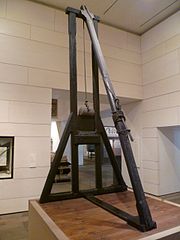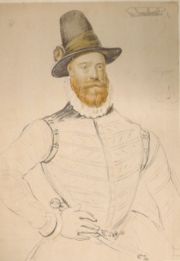- Maiden (beheading)
-
The Maiden (also known as the Scottish Maiden) is an early form of guillotine, or gibbet, once used as a means of execution in Edinburgh, Scotland. The Maiden is displayed at the National Museum of Scotland. (The word gibbet denotes several different devices used in capital punishment.)
Contents
History
According to legend, the Maiden was introduced to Scotland during the minority of King James VI, from Halifax, West Yorkshire, in the north of England, by the Regent James Douglas, 4th Earl of Morton. It is said that Morton borrowed the design from the Halifax Gibbet and carried a model of it from Halifax to Edinburgh. After it was built, it remained so long unused that it acquired the name of the Maiden.[1] Morton was eventually executed by it himself in 1581, although contrary to legend he was not the first person to be executed by it.
Although the resemblance to the Halifax machine, and Morton's role in introducing the Maiden are doubtful, the records of the construction of the Maiden survive. It was made in 1564 during the reign of Mary Queen of Scots.[2] The accounts reveal that it was made by the carpenters Adam and Patrick Shang and George Tod. Andrew Gotterson added the lead weight to the blade. Patrick Shang was paid 40 shillings for his 'whole labours and devising of the timber work.'[3] Shang also made furniture in Edinburgh, including an oak bed for Queen Mary's half-brother, the Earl of Moray.[4]
The first victim on record was Thomas Scott of Cambusmichael, as early as 3 April 1565.[5] From 1564 to 1708 over 150 people were executed on the Maiden, after which it was withdrawn from use. Notable victims included Archibald Campbell, 1st Marquess of Argyll in 1661, executed following the Restoration of Charles II, and his son Archibald Campbell, 9th Earl of Argyll in 1685, executed for leading a rebellion against James VII.
Morton's Maiden is on display at the National Museum of Scotland.
Mechanism
The person under sentence of death placed his head on a crossbar which is about four feet from the bottom. Lead weights weighing around 75 pounds (34 kg) were attached to the axe blade. The blade is guided by grooves cut within the inner edges of the frame. A peg, which is in turn attached to a cord, kept the blade in place. The executioner removed the peg by pulling sharply on the cord, and this caused the blade to fall and decapitate the condemned. If the condemned had been tried for stealing a horse, the cord was attached to the animal which, on being whipped, started away removing the peg, and became the executioner.[6]
See also
- Guillotine
- Halifax Gibbet
- Decapitation
- List of people who were beheaded
- Capital punishment
References
- ^ The history of the town and parish of Halifax By Samuel Midgley, William Bentley
- ^ McCulloch, W.T., 'The Maiden', PSAS, (1866-7), 549.
- ^ Adam, Robert, ed., City of Edinburgh Records, the Burgh accounts, vol. 1, Edinburgh (1899), 486-487.
- ^ HMC, 6th Report and Appendix, Earl of Moray, (1877), 647, the bed was new in 1562.
- ^ McCulloch, PSAS, (1866-7), 552.
- ^ The guide to knowledge, Volume 1 edited by William Pinnock
External links
Categories:- Execution methods
- Penal system in Scotland
- Collections of the National Museums of Scotland
- History of Edinburgh
- Execution equipment
Wikimedia Foundation. 2010.



